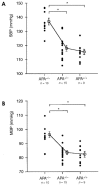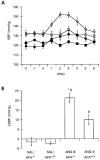Hypertension and angiotensin II hypersensitivity in aminopeptidase A-deficient mice
- PMID: 12765341
- PMCID: PMC1430374
Hypertension and angiotensin II hypersensitivity in aminopeptidase A-deficient mice
Abstract
Local concentrations of the vasopressor peptide, angiotensin II (AngII), depend upon the balance between synthesis and degradation. Previous studies of blood pressure (BP) regulation have focused primarily on the generation of AngII and its receptors, and less attention has been devoted to angiotensin degradation. Aminopeptidase A (APA, EC 3.4.11.7) is responsible for the N-terminal cleavage of AngII, a hydrolytic event that serves as a rate-limiting step in angiotensin degradation. To evaluate the physiological role of APA, we examined BP homeostasis in APA-deficient mice. We measured basal BP and BP with continuous infusion of AngII in APA mutant mice by tail-cuff method. We also evaluated the development and histology of AngII-targeted organs as well as urine excretion in these mice. Homozygous APA mutant mice were found to have elevated basal systolic BP when compared with heterozygous mutant and wild-type littermate mice. Infusion of AngII led to an enhanced systolic BP response in the APA-deficient mice. Despite the sustained elevation of BP in APA knockout mice, neither their renal and cardiac sizes nor their histological appearances were not different from control mice. Moreover, the volume, osmolality, and electrolyte content of the urine were normal in APA-deficient mice. APA deficiency increased baseline BP and enhanced the hypertensive response to increased levels of AngII. These findings indicate a physiological role for APA in lowering BP and offer novel insight into the mechanisms for developing hypertension.
Figures



Similar articles
-
Aminopeptidase A, which generates one of the main effector peptides of the brain renin-angiotensin system, angiotensin III, has a key role in central control of arterial blood pressure.Biochem Soc Trans. 2000;28(4):435-40. Biochem Soc Trans. 2000. PMID: 10961935 Review.
-
Lack of angiotensin II conversion to angiotensin III increases water but not alcohol consumption in aminopeptidase A-deficient mice.Regul Pept. 2006 Sep 11;136(1-3):130-7. doi: 10.1016/j.regpep.2006.06.001. Epub 2006 Aug 2. Regul Pept. 2006. PMID: 16889841
-
Catechol-O-Methyltransferase Deficiency Leads to Hypersensitivity of the Pressor Response Against Angiotensin II.Hypertension. 2017 Jun;69(6):1156-1164. doi: 10.1161/HYPERTENSIONAHA.117.09247. Epub 2017 May 1. Hypertension. 2017. PMID: 28461606
-
Deficiency of the Angiotensinase Aminopeptidase A Increases Susceptibility to Glomerular Injury.J Am Soc Nephrol. 2017 Jul;28(7):2119-2132. doi: 10.1681/ASN.2016111166. Epub 2017 Feb 15. J Am Soc Nephrol. 2017. PMID: 28202497 Free PMC article.
-
New insights into the importance of aminopeptidase A in hypertension.Heart Fail Rev. 2008 Sep;13(3):273-84. doi: 10.1007/s10741-007-9065-7. Epub 2007 Nov 8. Heart Fail Rev. 2008. PMID: 17990103 Free PMC article. Review.
Cited by
-
Aminopeptidases in Cardiovascular and Renal Function. Role as Predictive Renal Injury Biomarkers.Int J Mol Sci. 2020 Aug 5;21(16):5615. doi: 10.3390/ijms21165615. Int J Mol Sci. 2020. PMID: 32764495 Free PMC article. Review.
-
A cross-tissue transcriptome association study identifies key genes in essential hypertension.Front Genet. 2023 Feb 10;14:1114174. doi: 10.3389/fgene.2023.1114174. eCollection 2023. Front Genet. 2023. PMID: 36845374 Free PMC article.
-
Functional genetic variation in aminopeptidase A (ENPEP): lack of clear association with focal and segmental glomerulosclerosis (FSGS).Gene. 2008 Feb 29;410(1):44-52. doi: 10.1016/j.gene.2007.11.014. Epub 2007 Dec 3. Gene. 2008. PMID: 18206321 Free PMC article.
-
Isolation of primitive endoderm, mesoderm, vascular endothelial and trophoblast progenitors from human pluripotent stem cells.Nat Biotechnol. 2012 May 27;30(6):531-42. doi: 10.1038/nbt.2239. Nat Biotechnol. 2012. PMID: 22634564 Free PMC article.
-
Ang II and Ang IV: unraveling the mechanism of action on synaptic plasticity, memory, and epilepsy.CNS Neurosci Ther. 2008 Winter;14(4):315-39. doi: 10.1111/j.1755-5949.2008.00057.x. CNS Neurosci Ther. 2008. PMID: 19040556 Free PMC article. Review.
References
Publication types
MeSH terms
Substances
LinkOut - more resources
Full Text Sources
Medical
Molecular Biology Databases
Research Materials
